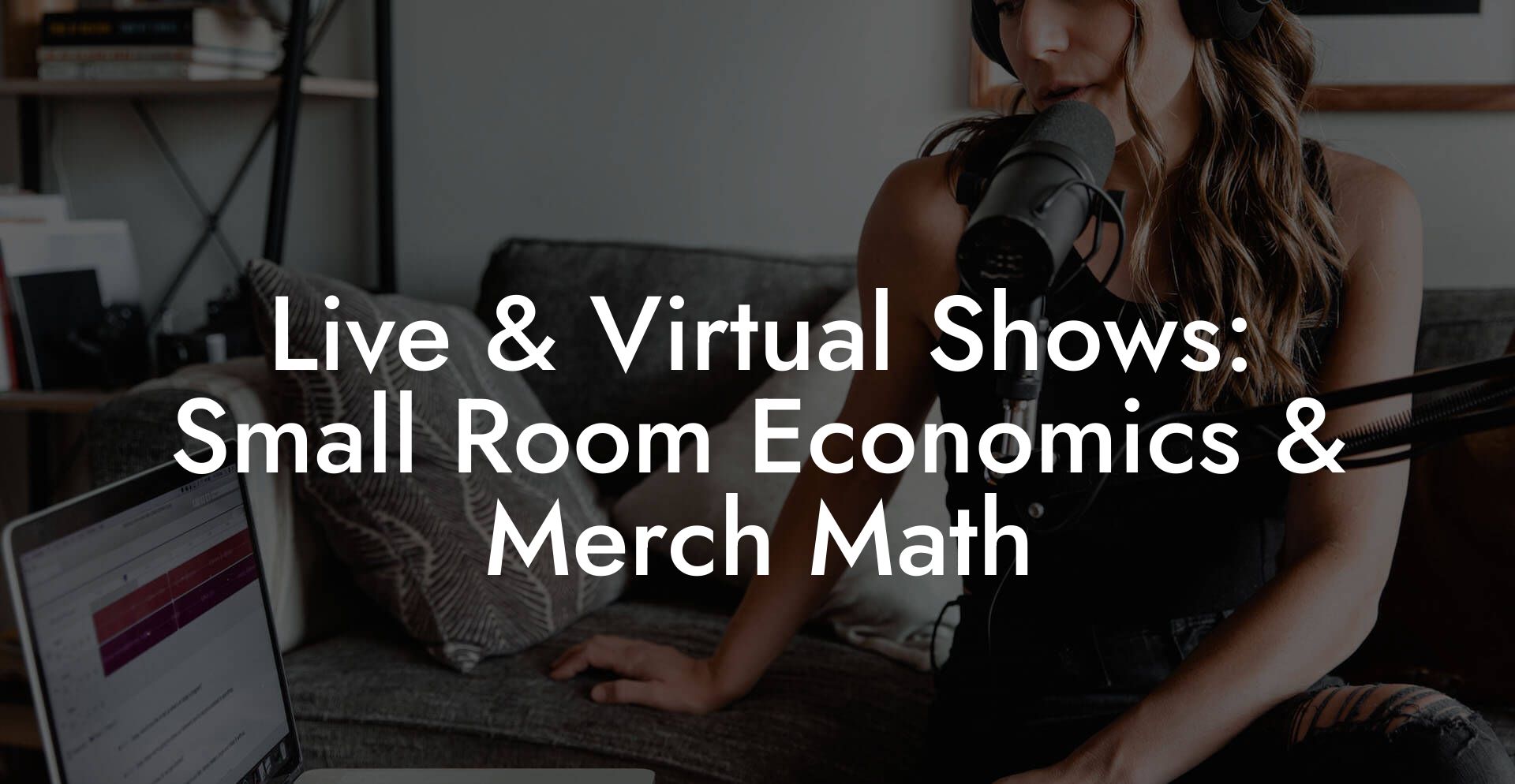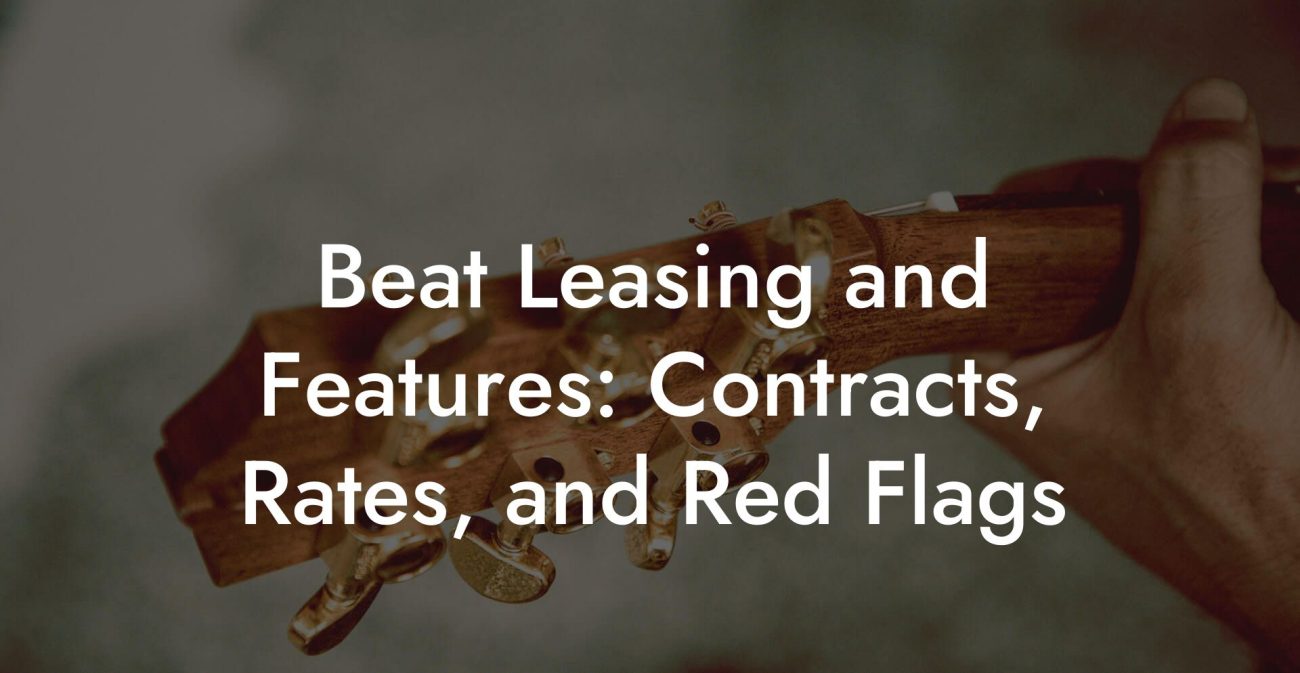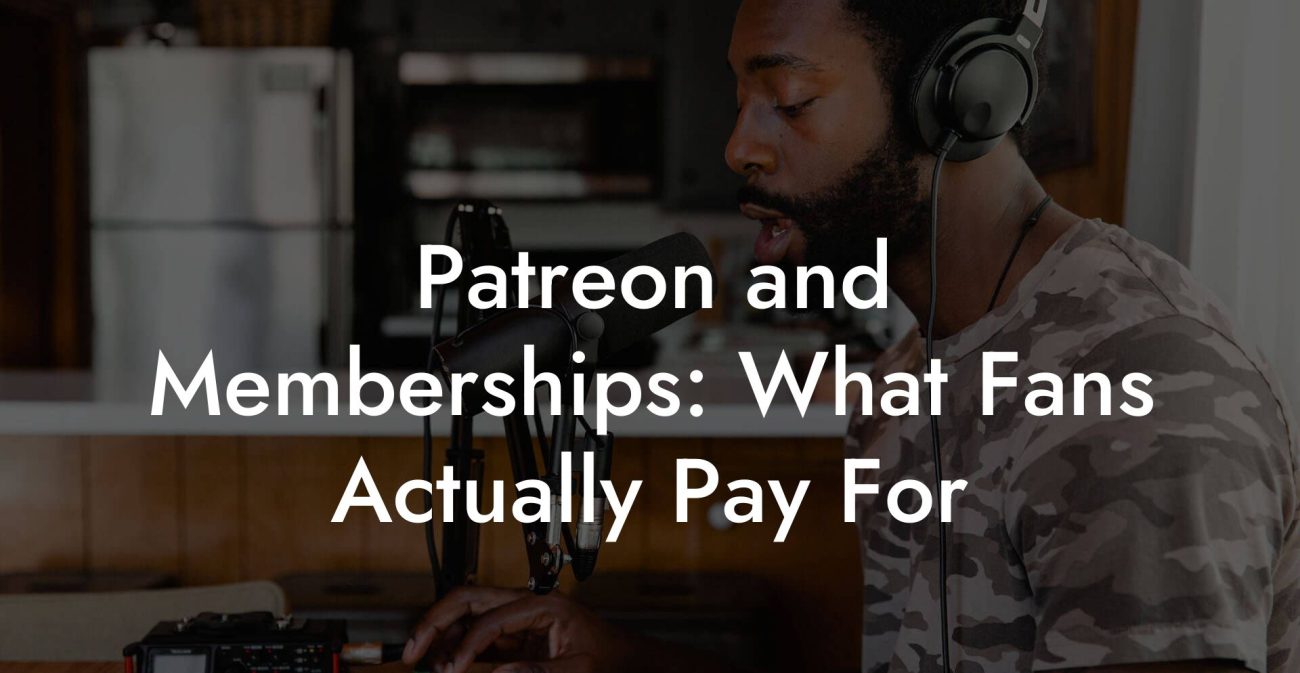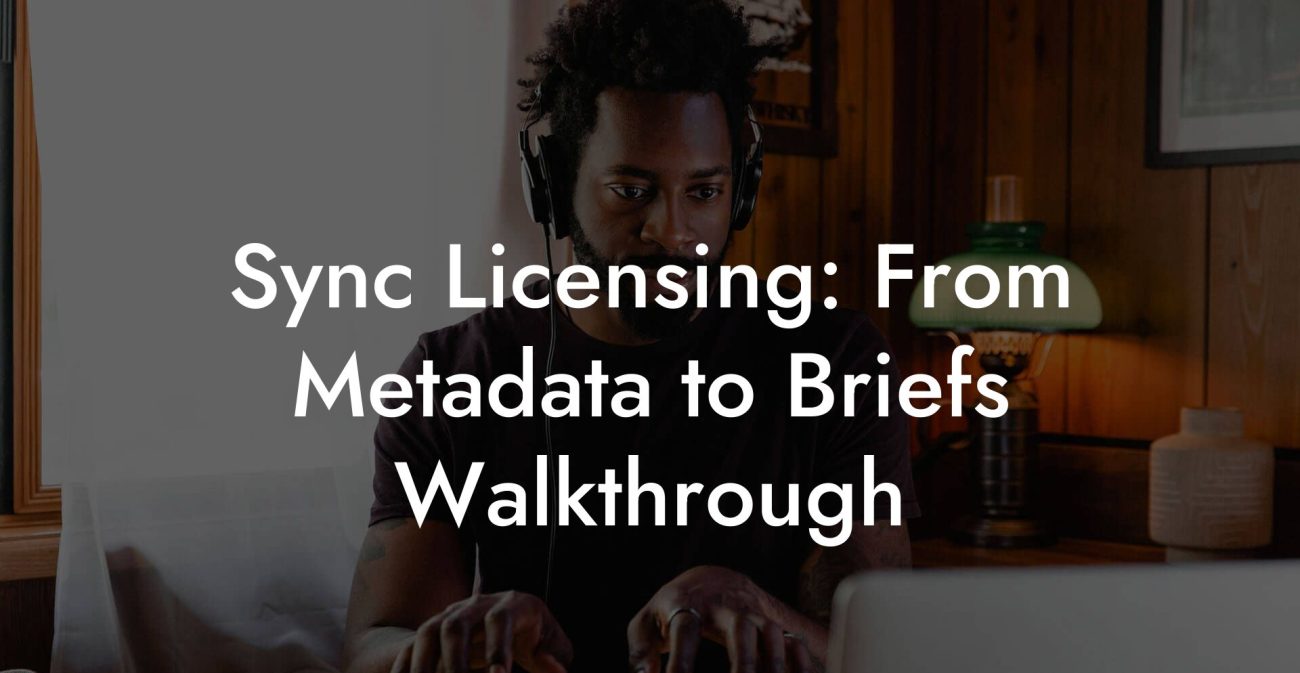Songwriting Advice
Live & Virtual Shows: Small Room Economics & Merch Math

If you play music for money and not for roommates applause, this guide is for you. We will walk through real world gig math from dingy 80 person basements to polished livestream stages. You will get ticket deal templates, merch pricing strategies, profit forecasts, platform basics, and actionable tactics you can use before your next sound check. No fluff. No industry language without translation. If I use an acronym I will explain it. If I use an example I will give you the receipts.
Quick Interruption: Ever wondered how huge artists end up fighting for their own songs? The answer is in the fine print. Learn the lines that protect you. Own your masters. Keep royalties. Keep playing shows without moving back in with Mom. Find out more →
Quick Links to Useful Sections
- Why shows still matter
- Key terms explained so you do not nod and forget
- Small room economics made human
- Real life example one
- Guarantee versus door split
- How to price tickets so people do not hate you and you do not lose money
- Anchor pricing
- Dynamic pricing for small rooms
- Virtual ticketing levels
- Merch math for people who hate numbers but like money
- Basic merch formula
- Inventory example with reorder
- Print on demand versus bulk printing
- Merch pricing psychology
- Merch table tactics that actually work in the real world
- Placement and presentation
- Staffing
- Cash and card strategy
- Taxes and basics you cannot ignore
- Virtual shows with real money potential
- Platform roundup in plain English
- Monetization options for virtual shows
- Real world virtual show math
- Marketing your show without selling your soul
- One month plan before the show
- Ad basics for virtual shows
- Upsells and bundles that raise average order value
- Bundle examples
- Tracking and measuring success
- Common mistakes and how to avoid them
- Playing free all the time
- Bad merch inventory choices
- Poor payment options
- Ignoring production quality on virtual shows
- Negotiation cheat sheet for deal making
- Examples you can steal tonight
- Example A
- Example B
- Action plan you can run before your next show
- FAQ
This article is for millennial and Gen Z artists who want to stop losing money on shows, grow a reliable revenue stream, and make merch that people actually buy. Expect blunt honesty, jokes you will text your bandmate, and spreadsheets in plain English.
Why shows still matter
Live shows do three things well for an artist. They put cash in your pocket now. They create fans who will pay you later. They sell merch that you can only sell in person with easy conversion. Virtual shows do most of the same things but trade some immediacy for scale and lower overhead.
If you treat live and virtual shows like experiments rather than miracles you will start to see predictable results. Predictable results let you plan inventory, hire a merch person, and finally pay for that synth you have been eyeing without crying in the practice room.
Key terms explained so you do not nod and forget
- COGS. Cost of goods sold. The amount it costs you to make one T shirt or one physical CD. Includes production and packaging but not your gas or merch person tips.
- ROI. Return on investment. How much cash you make compared to what you put in. If you spend fifty dollars on shirts and come back with two hundred dollars you have a good ROI.
- POS. Point of sale. The system you use to take money at shows like Square or Stripe connected checkout.
- SKU. Stock keeping unit. A tiny code you assign to a product so you know what sold. Nice for when fans demand a shirt you sold out of three years ago.
- Merch attach rate. The percentage of people who buy merch after attending your show. If 100 people attend and 15 buy something your attach rate is 15 percent.
- Guarantee. A flat payment a venue promises to an artist regardless of ticket sales. Good for risk free income when you do not expect a big crowd.
- Door split. The percentage of ticket revenue that the artist gets after the venue takes its share. Common splits are 70 30 or 60 40 but we will break this down.
- CPM. Cost per mille. Advertisers talk like this to say cost per thousand impressions or views. Useful when planning virtual show ads.
- D2C. Direct to consumer. Selling merch directly to fans without a third party taking a big cut.
Small room economics made human
Small room shows mean two things. Low capacity and low overhead. That sounds sad until you realize you can have a full house every week and a reliable merch income. Here is how the math looks for a typical 120 capacity room.
Real life example one
Scenario. You headline a 120 person room. You sell 70 tickets at twelve dollars each. Venue offers you a 70 percent door split after ticketing fees. Ticket platform charges ten percent of gross ticket sales. You sell merch at the show and your attach rate is 12 percent.
Numbers
- Gross ticket sales. 70 tickets times twelve dollars equals eight hundred forty dollars.
- Ticket fees. Ten percent of eight hundred forty equals eighty four dollars. Net from ticketing platform is eight hundred forty minus eighty four equals seven hundred fifty six dollars.
- Door split to artist. Seventy percent of seven hundred fifty six equals five hundred twenty nine point twenty five dollars.
- Merch. 12 percent attach rate means about eight or nine buyers. Average merch spend of thirty dollars equals about two hundred seventy dollars.
- Merch COGS. If your average cost per item after printing and bagging is ten dollars the cost for nine items is ninety dollars. Gross merch profit equals two hundred seventy minus ninety equals one hundred eighty dollars.
- Total payday. Five hundred twenty nine point twenty five plus one hundred eighty equals seven hundred nine point twenty five dollars before travel and rider costs.
That is not bad for a small room night. Now add a merch upsell like a signed poster for twenty dollars and your attach rate or average order value increases. Add a virtual ticket sale recorded during the show and you add recurring revenue later. You are building layers.
Guarantee versus door split
When a promoter offers a guarantee they say how much they will pay you no matter what. Guarantees reduce risk. They are helpful when you open for a larger act or play a new city and you do not expect to pack the room. If the venue offers a guarantee make sure it covers your travel costs and pays something for your time.
If the promoter or venue offers a door split you will want to ask two questions.
- Who handles ticketing and what fees are deducted before the split?
- What is the expected attendance? It helps to get a conservative estimate and a high estimate so you can plan merch and staffing.
How to price tickets so people do not hate you and you do not lose money
Pricing is psychology plus math. You want a range that matches your perceived value and gives you breathing room for discounts. Here are tactics and numbers that actually work.
Anchor pricing
Offer one premium option and one standard option. The premium gives instant perceived value. Example. General admission ten dollars, early entry or limited VIP twenty five dollars. Your brain might scream that no one will buy VIP. They will. Many fans want to support and a few will pay extra to feel seen.
Dynamic pricing for small rooms
Small rooms are not airlines. Do not overcomplicate. Use two tiers early bird and regular. Early bird rewards people who commit and helps you forecast. The early bird should be a modest discount like two or three dollars. Make the early bird limited in quantity to trigger urgency.
Virtual ticketing levels
For virtual shows give a low price for streaming and a higher price for streaming plus a merch bundle or a recorded download of the performance. Fans who value the experience will choose the bundle and you will recoup production costs.
Merch math for people who hate numbers but like money
Merch is profit architecture. The key is to control COGS and to increase average order value with bundles. Here is the arithmetic and the tactics.
Basic merch formula
Profit per item equals sale price minus COGS minus transaction fees. If you sell a shirt for thirty dollars and your COGS is ten dollars and processing fees average three dollars your profit per shirt is seventeen dollars. Multiply profit per item by units sold and subtract fixed costs like table fee to get net merch profit.
Inventory example with reorder
You order one hundred shirts at ten dollars COGS each. Total production cost one thousand dollars. You sell twenty five shirts on tour. At that rate you will sell a hundred shirts on four similar shows. But just because you bought one hundred shirts does not mean you will sell them fast. Plan reorder points. If your reorder lead time is two weeks place a reorder when your on hand inventory equals average weekly sales times lead time plus safety stock.
Translation. If you sell ten shirts per week and suppliers need two weeks to make more, reorder when you have about twenty five shirts left to avoid selling out of your best seller during a peak weekend.
Print on demand versus bulk printing
Print on demand is low risk. You order one by one after sales. That reduces inventory costs. Bulk printing lowers COGS per item and increases margins but costs up front. Use print on demand for experimental designs and bulk for staples like your logo tee.
Merch pricing psychology
- Use rounded prices for premium items like fifty dollars for a jacket. Rounded numbers can feel more premium.
- Use odd pricing on lower priced items like nine dollars for a sticker. It triggers bargain feel.
- Offer three price tiers. Most people pick the middle option.
- Use scarcity language for limited runs. Fans respond to limited availability more than to discounts.
Merch table tactics that actually work in the real world
Placement and presentation
Set your merch table where people pass on the way out. Put your most eye catching item at chest height. Use a cheap tablecloth that looks clean. Bundle items into clear groups and put a small sign with prices on a cheap frame so buyers do not ask how much. People will ask anyway but you will convert more people this way.
Staffing
Hire someone outgoing who can handle cash and talk to fans. Pay them a flat fee or a commission plus base. Commission motivates sales. If your math allows pay five dollars per item sold or ten percent of sales. This can increase conversion more than you expect.
Cash and card strategy
Bring a cash float and use a mobile POS to accept cards. If you accept Venmo or Cash App display a QR code. Make sure your phone battery is charged and you have a portable charger in case your merch person becomes the hero of the night and drains the phone.
Taxes and basics you cannot ignore
Sales tax varies by jurisdiction. If you sell at a merch table you may need to collect sales tax at the rate for that city or state. Many festivals will ask you for a copy of your seller permit. Online platform sales may require you to collect tax as well. Keep records. Use simple accounting software or a spreadsheet. Pay your taxes like a grown up so the IRS does not send you a letter that ruins your day.
Virtual shows with real money potential
Virtual shows are a different animal. They scale well and have near zero physical overhead. You just need the right platform and monetization plan. Here are the core choices and how to make them profitable.
Platform roundup in plain English
- Twitch. Live streaming platform built for engagement and tipping. Fans can subscribe monthly or donate bits. Good if you want recurring fans and long term discovery.
- YouTube Live. Works well for existing audiences. Offers ad revenue for creators who monetize. You can sell tickets through integrated platforms.
- Facebook Live. Good for targeting existing fan communities. Pay attention to discovery and groups.
- StageIt. Platform built for ticketed virtual shows where fans tip and can request songs. Takes a cut so read terms.
- Zoom. Great for small exclusive shows. Allows meet and greets with small groups and personal interactions. Use ticketing outside of Zoom then send private links.
Pick one platform and learn its monetization mechanics. Do not stream on every platform at once unless you have the team to handle multi chat and moderation.
Monetization options for virtual shows
- Ticketed streaming with multiple tiers.
- Pay per view recorded content you can sell later.
- Tips and donations during the show.
- Merch bundles shipped after the show or available for pickup.
- Sponsorships from brands or local businesses if your audience fits their target market.
Real world virtual show math
Example. You charge ten dollars for a live stream and get 250 viewers. Platform fees and payment processing take around 10 to 15 percent combined. Your gross revenue is two thousand five hundred dollars. After fees you keep about two thousand one hundred to two thousand two hundred dollars. If you send a merch bundle to a subset of fans you must subtract shipping and cost of the bundle. Virtual shows allow you to keep high margins if you avoid expensive production unless you sell that production as premium content.
Marketing your show without selling your soul
Marketing is what fills seats and streams. You do not need a massive ad budget. You need consistent outreach, smart partnerships, and clear calls to action. Here are tactics you can actually execute in a week.
One month plan before the show
- Week four. Announce the show with a pinned post and an event page. Add basic details and early bird pricing. Ask friends to RSVP to create social proof.
- Week three. Release a short video or live performance clip. Use targeted social ads to reach local people who like similar acts. Spend a small amount like five to ten dollars a day and test creative.
- Week two. Send an email to your mailing list with a clear call to buy tickets and a reminder about VIP options. Use a subject line that feels personal not spammy.
- Week one. Run stories and countdowns. Partner with the venue and ask them to share your content. Reach out to local music blogs or campus radio. Offer two free guest list spots to a local influencer for social reach.
- Day of show. Post a last minute clip and encourage walk ups if allowed. Share merch sneak peeks so fans know what they can buy.
Ad basics for virtual shows
If you run ads target lookalike audiences based on your existing followers. Use a short clip of your live performance as the creative. Track conversions and set a small budget. Your goal is not to go viral. Your goal is to hit break even and then grow the audience that watches again.
Upsells and bundles that raise average order value
Bundles are the silent profit engine. Create clear bundles and price them so fans feel like they are getting value not being charged more.
Bundle examples
- Streaming ticket plus digital download and exclusive sticker for a single bundle price.
- Shirt plus signed poster plus a download of the live show at a small discount compared to buying items separately.
- Meet and greet upgrade for a small group limited to ten people. Use Zoom for virtual meet and greets.
Bundles increase perceived value and make processing inventory simpler. They also make better social media content because bundles look like rewards.
Tracking and measuring success
Track these six metrics and you can call your tour a business not a hobby.
- Net revenue per show. After fees travel and taxes.
- Merch attach rate. Percentage of attendees who bought merch.
- Average order value. Total merch revenue divided by units sold or orders placed.
- Ad cost per ticket. How much you spent on ads divided by tickets sold from ads.
- Repeat buyer rate. How many buyers buy again in a six month window.
- Virtual retention. For virtual shows track how long viewers stayed and how many returned the next month.
Common mistakes and how to avoid them
Playing free all the time
Free shows are fine for exposure early on. Do not default to free as a habit. If you play without charging you teach fans that your work is not worth money. Test low ticket prices and watch how fans behave. Many will pay something just to support you.
Bad merch inventory choices
Do not order five different shirt colors in four sizes if you cannot sell that many shirts. Start with one staple design in sizes small to extra large. Test colors later. Use pre orders for experimental items to avoid dead stock.
Poor payment options
If you only accept cash you lose sales. If you only accept cards you lose tips. Offer both. Offer digital payments and make it easy to tip via QR codes. Fans will tip when the experience is worth it.
Ignoring production quality on virtual shows
Audio matters more than video. Invest in a good microphone and basic audio routing. Fans will forgive shaky camera but not bad sound. Learn simple mixing and do a quick sound check with a friend before showtime.
Negotiation cheat sheet for deal making
When a promoter offers you a deal use this checklist before you sign anything.
- Is this a guarantee or a door split?
- Who handles ticketing and what fees are charged?
- Is there a merch fee or a table charge?
- What are the expected attendance numbers and who is the headliner?
- What is the load in time and how many minutes do you have for sound check?
- What payment terms do they offer after show? Same night or net thirty days?
If the promoter wants exclusivity on date ask for compensation in the guarantee. If they ask for a low guarantee because you are a draw suggest a door split with a guarantee floor. The goal is to make the risk share fair.
Examples you can steal tonight
Example A
Local show. Capacity 150. You expect 90 tickets sold. Price ten dollars. Ticket platform fees ten percent. Venue split 70 percent. Merch average order value twenty five dollars. Attach rate fifteen percent. Result net payday around eight hundred to nine hundred dollars. Plan to reinvest thirty percent into marketing and merch restocking.
Example B
Virtual show. Ticket price ten dollars. 300 viewers. Platform fees fifteen percent. Bundle option for an extra fifteen dollars which includes digital download and signed merch purchased by 40 buyers. Net revenue about two thousand two hundred to two thousand five hundred dollars depending on shipping. Cost is mainly fulfillment time and packaging. Keep the recording to resell afterward for extra revenue.
Action plan you can run before your next show
- Decide a ticket pricing structure with at least two tiers. Set an early bird price and a standard price.
- Pick three merch items to bring. One staple shirt, one low cost item like a sticker, and one premium item like a signed poster.
- Set up a POS system like Square and create QR codes for Venmo or Cash App. Test them in practice.
- Create a one page merch sign with prices and bundle offers so buyers do not have to ask for every price.
- Schedule social posts for the four weeks before the show following the one month plan.
- Decide whether you will insist on a guarantee or accept a door split and what your minimum acceptable payment is.
- Prepare a short email to your mailing list with VIP options and a simple call to action to buy tickets now.
FAQ
What is a healthy merch attach rate for small room shows
A realistic attach rate is between ten and twenty percent depending on genre and crowd. If you are selling physical merch to a crowd that loves physical things like indie rock or punk your attach rate could be higher. Use attach rate to forecast inventory and staffing. If your attach rate is low consider price points and presentation rather than blaming the crowd.
Should I always take a guarantee
Take a guarantee if it covers your travel and basic costs and pays you for your time. If you have a solid draw you can negotiate a guarantee plus a percentage of door after a threshold. Guarantees protect you against low turnout and are especially valuable in new territories.
How much should I charge for VIP spots or meet and greets
Price VIPs based on perceived value and your capacity to deliver. For small room shows a ten to twenty five dollar premium is common for early entry. For intimate meet and greets or photos charge fifty to one hundred dollars depending on demand. Make the VIP worth the price by keeping the group small and giving something exclusive like a signed poster or a short acoustic set.
Which platform is best for virtual pay per view shows
There is no single best platform. Twitch is great for tipping and community building. StageIt and similar niche platforms are built for ticketed shows. YouTube and Facebook work well if you already have followers. Consider your goals. If you want recurring subscriptions pick Twitch. If you want a one off paid event choose a ticketed platform or use Eventbrite to sell tickets and stream via Zoom for exclusivity.
How can I reduce merch COGS without losing quality
Buy in bulk for basics and use print on demand for experimental designs. Negotiate with local screen printers and ask for samples before large orders. Use higher margin items like pins and posters that cost less to produce but sell at attractive markups. Factor packaging and shipping into COGS so there are no surprises.
How do I forecast revenue for a small tour
Use a simple spreadsheet. For each show list expected attendance expected ticket sales merch attach rate average merch spend guarantee or split and fixed costs like travel and lodging. Sum across shows and subtract expenses. Add a buffer for worst case. This forecast will tell you whether the tour pays or whether you need to add headline dates or virtual shows to break even.




